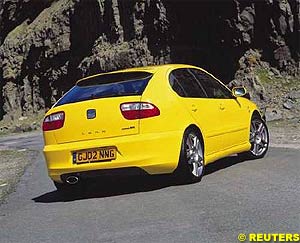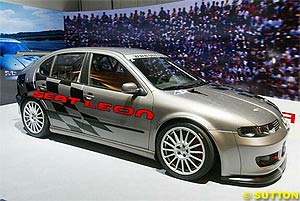

Automotive News and Reviews for the Petrolhead
Reuters Motoring Commentator
In this week's issue:
- BMW to Make Cars in Booming China
- Raise a Glass to SEAT's Leon Cupra R
BMW has signed a deal to produce the German luxury cars in China, one of the world's fastest-growing car markets.
"China is one of the most important stepping stones in our strategy," BMW Chairman Helmut Panke said. "Many of us believe China will be the largest market in the world."
Under the long-awaited deal, BMW and Brilliance China Automotive Holdings, China's largest van maker, will invest 450 million euros in the venture by 2005, with each holding a 50 percent stake, the companies said. The venture -- formalised at a signing ceremony in Beijing's Great Hall of the People -- will make cars at a Brilliance factory in the northeast city of Shenyang, with production starting in the second half of this year.
It would make some 30,000 3 Series and 5 Series cars a year in the "medium term", Panke said.
Executives did not discuss a wrangle over ownership of a big chunk of Brilliance with its former chairman Yang Rong, who has been sought by mainland authorities for alleged economic crimes.
Once one of China's richest men, Yang has denied any wrongdoing and has filed suit in Bermuda contesting the sale of a 39.45 percent stake in Brilliance to a firm controlled by the Liaoning provincial government at a more than 90 percent discount to its market value at the time the deal was announced. Panke did not address the lawsuit, but said; "Brilliance has a clear track record of having the same philosophy, process and management strategy as within BMW Group."
Strong Reputation
China's red-hot car market saw sales soar 60 percent last year to 1.2 million, becoming the world's fourth biggest automotive market behind the United States, Japan and Germany, according to market research firm Automotive Resources Asia.
Foreign giants have rushed to get a slice of the China market, with Ford Motor Co of the United States and Japan's Toyota Motor Corp among the latest to start rolling cars out of domestic factories.
BMW exported about 6,800 cars to China in 2002, a rise of 60 percent from the previous year, Panke said. He added that sales this year were expected to rise even faster, thanks in part to the new venture.
But BMW faces stiff competition from Volkswagen AG's Audi, which has dominated the luxury market with a venture with First Auto Works, China's top automaker, which makes about 35,000 cars a year. While China's auto sector has been boosted by a spurt of new economy models hitting the market, more Chinese are eyeing up-scale cars.
Of the 70,000 cars China imported last year, about two-thirds cost around 400,000 yuan, showing a strong appetite for high-end models, said Automotive Research analyst Yale Zhang. And BMW's reputation for melding performance and luxury was making inroads with Chinese consumers, Zhang said.
"Chinese are similar to people in the United States or Europe as to how they perceive this brand. BMW's performance, the fun of driving, and the quality make them really well received by Chinese," Zhang said.
The move is the latest expansion into Asia by the German carmaker, which has factories in Malaysia, Vietnam, the Philippines, Indonesia and Thailand, and aims to double its Asian sales over the next five years.
On the basis that a glass is either half full or half empty, the SEAT Leon Cupra R is either: a) sensational or b) err, a SEAT.
There is no middle ground. On the one hand, the half-full brigade (cheerful and optimistic) will be able to make an objective value judgement on the SEAT's looks, capabilities and price. To the other lot (pessimistic and cynical), it's just a SEAT (whatever that may be).
New Owner, Same Name
By 1986, however, SEAT had become a part of the Volkswagen Group, the temperamental Latin partnership with FIAT being replaced by efficient, Germanic ownership. Which is no bad thing when the new landlord also happens to be a byword for quality, reliability, engineering integrity and rock-hard residuals. In fact, all the things that SEAT was not. This is, of course, the way of the modern world. Scale is what counts and the economies of scale count double, which is why today the VW Group owns Audi, Bentley, Bugatti, Lamborghini, SEAT and Skoda (not forgetting that they also build Volkswagens too).
All of which means that more than ever before, motor cloning is the order of the day. Call it what you like badge-engineering, platform-sharing, MAGPIE (multi-auto group pilfering, integration and engineering). OK, so I made the last one up, but you get the idea. The simple fact is that what we lose in individuality we gain in quality.
So, as a product of the Volkswagen Group, when is a SEAT Leon not a SEAT Leon? When it's a VW Golf, of course. In the same way that the Alhambra (SEAT's MPV) is based on a Volkswagen (the Sharan), so the Leon is really a Golf. It's just that in its Cupra R guise, the Leon is no ordinary Golf. In fact it positively upstages its more feted brethren.
A Sporting Showcase
In the good old days (that is to say the 1980s) the Cupra R would have been known as a hot hatch, the progenitor of which was the original (1976) Golf GTi. How ironic is that? Hot hatch is too trivial a term to describe this car though. This is the fastest and the best SEAT ever made and it was conceived as a showcase for the Spanish firm's sporting ambition. And a damn fine job it has made of it.
The Cupra R packs a mighty punch, developing 210bhp from its 20 valve, 1.8 litre turbo-charged engine. Performance is outstanding. The Leon pulls hard in any of its six gears, on to a maximum of 147mph. In first, second and third the car is actually quite mad, passing 62mph in just 7.2 seconds. The standard fitment of a series of advanced electronic driver aids helps to keep this rapid progress neat and tidy but should you be so thoughtless as to switch off the ESP (Electronic Stability Programme), injudicious use of the right foot will ensure matters quickly become rather more unruly.
Think about it 210bhp through the front wheels is always likely to be a handful. The clever gizmos (it also features an electronic differential and traction-control system) complement this SEAT's revised suspension, lowered and fettled by SEAT Sport in Barcelona, to create a fabulous driving experience but without them, the car would be an utter hooligan. You sense that without the technology, the Cupra R would (mis)behave like a juvenile serial offender; an automotive vandal with motoring Tourett's Syndrome.
Wonder Wheels
On the down side there is more body roll than expected (the MINI Cooper S, for example, corners much flatter) and even with ESP on, you can feel the front end is reluctantly resisting the urge to understeer into oblivion.
Inside, the Cupra R is a fine place to be. A predominantly black colour scheme lends the car an appropriately sporting image and, overall, the materials used are of a decent quality. The test car had over 11,000 miles on the clock too and it was reassuringly squeak-free. It has to be said that this still leaves the SEAT shy of the best German build-quality standards but equipment levels are lavish, the only options being the excellent Recaro seats and the equally impressive satellite navigation system. Standard equipment includes electric windows all round, automatic air-conditioning, CD autochanger and electrically operated, heated and folding rear-view mirrors. The only reservation I had about the cabin is that there is not enough room for the driver (although at 6ft 4ins, this is a recurring problem) and the rear is best suited to children or residents of Lilliput. Considering that the boot is positively cavernous, this all seems a bit of a shame and for a five-door car, the internal dimensions didnąt seem to quite stack-up.
A Good Looker
What does stack-up is the Cupra R's price. At Ł16,995 it is by no means cheap, but there are precious few alternatives for this kind of money. The Civic Type R offers similar performance for a grand less but has a much lower standard specification and two fewer doors. By the time you've added dealer-fit air-conditioning, it's more expensive. The Focus RS is faster (and apparently the new 'daddy' of the sector) but again, has just the three doors and will stand you Ł3,000 over the odds. Only the (three-door) Vauxhall Astra GSi Turbo undercuts and outperforms the Cupra R but the margins are tiny and overall, the SEAT is much the better-looking and more involving car.
SEAT has come a long way since 1950 and it is worth pointing out that this success owes at least as much to the investment of post-Franco Spanish Governments as it does to VW. Forget those re-badged FIAT Pandas you hired in Malaga 10 years ago and treat yourself to a Leon Cupra R in black. This is one glass that is most definitely half full.
![]() BMW to Make Cars in Booming China
BMW to Make Cars in Booming China
![]() Raise a Glass to SEAT's Leon Cupra R
Raise a Glass to SEAT's Leon Cupra R
 SEAT (pronounced say-at), for the benefit of the uninitiated, is a Spanish car company that was reluctantly given the go-ahead by General Franco in 1950 (see, even he didn't really want one). His fear was that car manufacturing symbolised industrial modernisation, a very bad thing in his view, and that Spain would consequently become "a society plagued by materialism". Fat chance. A SEAT was hardly what you might describe as an object of desire. Eventually the company entered into an alliance with FIAT (well, misery deserves company) and thousands of workers were employed to take the badges off old FIATs and replace them with badges that said SEAT, transforming dubious Italian dross into unequivocal Spanish rubbish.
SEAT (pronounced say-at), for the benefit of the uninitiated, is a Spanish car company that was reluctantly given the go-ahead by General Franco in 1950 (see, even he didn't really want one). His fear was that car manufacturing symbolised industrial modernisation, a very bad thing in his view, and that Spain would consequently become "a society plagued by materialism". Fat chance. A SEAT was hardly what you might describe as an object of desire. Eventually the company entered into an alliance with FIAT (well, misery deserves company) and thousands of workers were employed to take the badges off old FIATs and replace them with badges that said SEAT, transforming dubious Italian dross into unequivocal Spanish rubbish.
 In fairness, the Cupra R does have the gadgets and it uses them well. Under normal conditions, it is a very civilised performer. The engine is equally impressively engineered, the old days of all-or-nothing are a thing of the past. You barely notice that the Cupra is turbocharged at all in fact, save for a feint whistle and that small 'oh-my-God' moment as the thing comes on song (in first and second mainly). Instead, the Leon simply pulls and pulls and pulls. The steering is a thing of wonder. Yes, it's heavy and, yes, it makes the car harder to park, but when it counts, when you're charging into and out of a deserted roundabout for example, it is wonderfully communicative and balanced. The overall feeling is all very race car - stiff, low and responsive, with braking to match. Large red-painted Brembo callipers are clearly visible through the stunning 18ins alloy wheels and their function is every bit the equal of their form.
In fairness, the Cupra R does have the gadgets and it uses them well. Under normal conditions, it is a very civilised performer. The engine is equally impressively engineered, the old days of all-or-nothing are a thing of the past. You barely notice that the Cupra is turbocharged at all in fact, save for a feint whistle and that small 'oh-my-God' moment as the thing comes on song (in first and second mainly). Instead, the Leon simply pulls and pulls and pulls. The steering is a thing of wonder. Yes, it's heavy and, yes, it makes the car harder to park, but when it counts, when you're charging into and out of a deserted roundabout for example, it is wonderfully communicative and balanced. The overall feeling is all very race car - stiff, low and responsive, with braking to match. Large red-painted Brembo callipers are clearly visible through the stunning 18ins alloy wheels and their function is every bit the equal of their form.
© 1995-2005 Kaizar.Com, Inc. . This service is provided under the Atlas F1 terms and conditions.
|
Volume 9, Issue 14
Atlas F1 Exclusive
The French Connection: OPT Uncovered
Pizzonia: From Jungle to Jungle
Giancarlo Fisichella: Through the Visor
Articles
Karl Kling: An Appreciation
2003 Brazilian GP Preview
2003 Brazilian GP Preview
Between the Lakes
Brazilian GP Facts & Stats
Columns
The 700th GP Trivia Quiz
Bookworm Critique
On the Road
Elsewhere in Racing
The Weekly Grapevine
> Homepage |